Our customer success strategies are low touch, high impact, and easy to scale for growing businesses. We’ll walk you through 9 real customer success campaigns we use at Groove and how we measure their success.
“Can we get notified when customers export their data?” our Head of Customer Success asked.
“Sure, we can create an automation that sends an email to the inbox whenever a customer exports their conversations. Wait, why?” responded our Chief Product Officer.
“Well, it’s a possible sign that they’re planning to move their data to another platform. If we get an alert, we might be able to step in and rescue the account,” she explained.
This is customer success in a nutshell.
You might not know you’ve been doing it. If anyone on your team is devoted to customer needs (whether they call themselves customer service, support, success, or otherwise…), they have probably dipped their toes into the customer success pool.
Today, we’ll show you how we structure our customer success strategies here at Groove. As a small business, we focus on easy implementation and scalable replication.
Our Head of Customer Success & Support runs, well, both success and support. We’re proof that you don’t need a large team or a huge budget to dedicate time to customer success.
Table of Contents
What is customer success?
I’m not going to bore you with a bloated, jargon-filled customer success definition.
But as possibly the only person writing about customer success who has actually done customer support (and customer experience), I want to expose a flaw in most definitions of the term.
Customer success is often positioned against customer service, support, or experience. In the worst accounts, it’s touted as “better than.” In others, it’s still defined by how it differs from those fields.
I want to make it very clear that in practice (at least in successful practice) customer success is blended into customer service, support, and experience. Especially at startups or small businesses. These terms are just terms. The practice of any one relies on and includes the others.
Now, why do I need to explain this? Because in my experience, business owners often think their customer support team can’t take on customer success tasks. They think they need to wait to hire a dedicated team before implementing any success strategies. And it’s all because these terms are defined in such opposition.
When you understand that your support rep can take on success tasks, and your support manager can drive customer success metrics, you can move forward without feeling like you’re doing it “the wrong way.”
I’ve done customer support, customer experience, customer advocacy… Regardless of my title, customer success strategies were on my plate. As they should be.
Here’s my definition: Customer success is a method of serving customers that enables them to get the most value from your product or service for their own benefit.
You can do this with a small team. You can do this with no team at all. You can do it with a support team, a service team, a success team. Don’t let the nuances fool you.
Now that my bone is picked, hopefully you feel capable of trying some customer success strategies even if it’s not in your job title.
9 customer success strategies that actually scale at our lean startup
To give some context for the following examples, Groove is B2B SaaS business—our product is customer support software. Some of these strategies might work for your business too. Some might not.
The common thread for each is that we do it all through email. We rely on our email marketing software to scale and automate each strategy. Balancing low-touch and high-impact is what startup life is all about.
Find the ones that resonate with your customer base or business model and adapt them to your needs.

Customer success strategy #1: Following up with a potential customer from the blog
Our founder has written at length on why he doubles down on content marketing. The short of it, though, is that we focus most of our marketing efforts on gaining new customers through our blog.
Each post includes a prompt encouraging readers to provide their email address.
Customer success takes the reigns from here.
We use our email marketing software to automatically send a message asking if you’re interested in our software.

If you respond, great. We keep moving down the funnel and start you on a trial.
If you don’t respond, we let it go.
Some “customer success experts” might scoff at the thought. But truth be told, we tried a sequence of several emails following up with these blog leads. The sequence had way too many unsubscribes and way too little opens.
You don’t need a lot of fancy success metrics to tell you the obvious: We were annoying people.
So we stick to one email now. If it converts a few new customers each month, that’s a win.
But we also know that by not pestering these blog readers, they’ll continue to read the blog, open our marketing emails each week, and maybe sign up down the road when they’re ready.
Customer success strategy #2: Reaching out to a potential customer after viewing a demo video
There are a few pages on our website that we consider “high converting.” I’ll let our marketing posts carry most of the weight if you’d like to learn more. But essentially, these pages are usually the last ones people land on before they sign up to use our product.
They’re a big deal. These people are very clearly looking to purchase. It can be a slam dunk for customer success.
One way we “capture” these would-be customers is by asking them to enter their email address before viewing our demo video. This allows us to follow-up from customer success and continue the conversation.
We set up a simple email campaign introducing ourselves with a link to start their free trial.
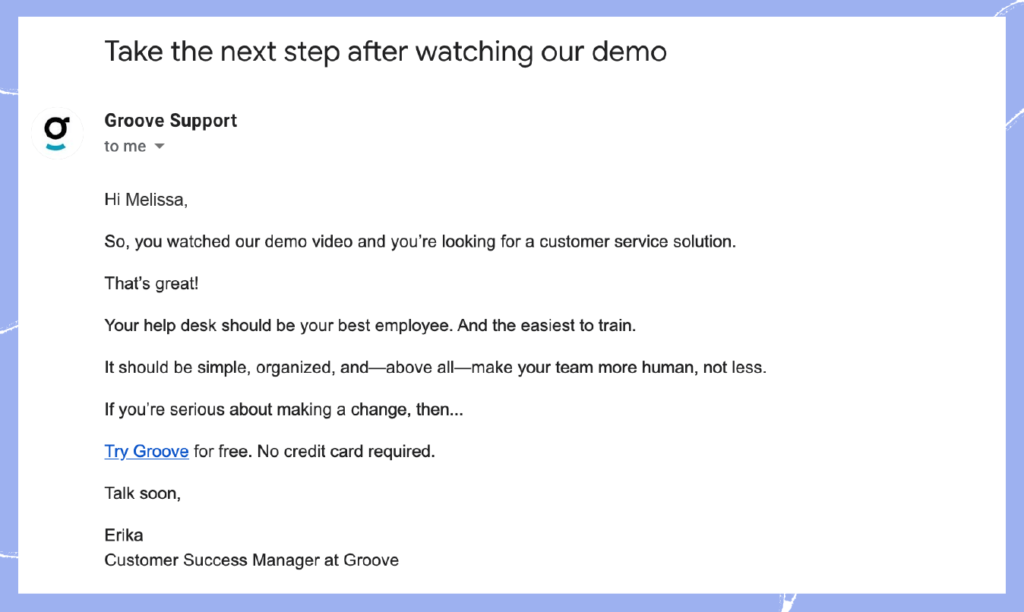
It’s a subtle nudge that typically works.
Customer success strategy #3: Checking in with current customers as they hit benchmarks
Once customers are in the door, with onboarding behind them, our customer success team focuses on relationship building.
Our developers set up notifications to alert the customer team when someone hits certain benchmarks. One example is when an account adds a tenth user.
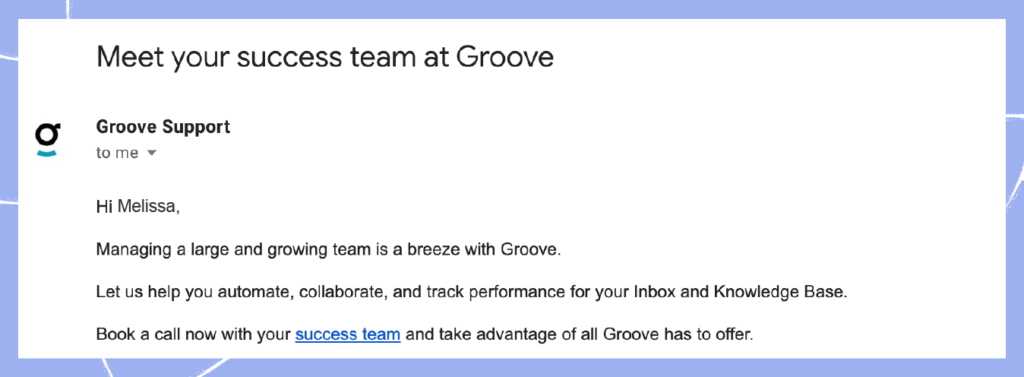
For our product, this tips us off that the customer’s business is growing. They’ve hired more team members. We’re able to check in with them during this typically high-stress time to see if they need any help.
We use these assumptions and automations to anticipate our customers’ needs and improve their success with our product.
Customer success strategy #4: Educating current customers on unused features
This happens often with SaaS or technology products. The UX is great. New customers breeze through onboarding. Get quickly set in their ways. And stop exploring.
They eventually get frustrated. Or hear about a competitor offering more features. They decide to take their business elsewhere.
The proactive side of customer success is all about preventing this stagnation before it ever takes shape.
At Groove, we send educational emails prompting current customers to try new features. We include use cases and examples to prove the point.
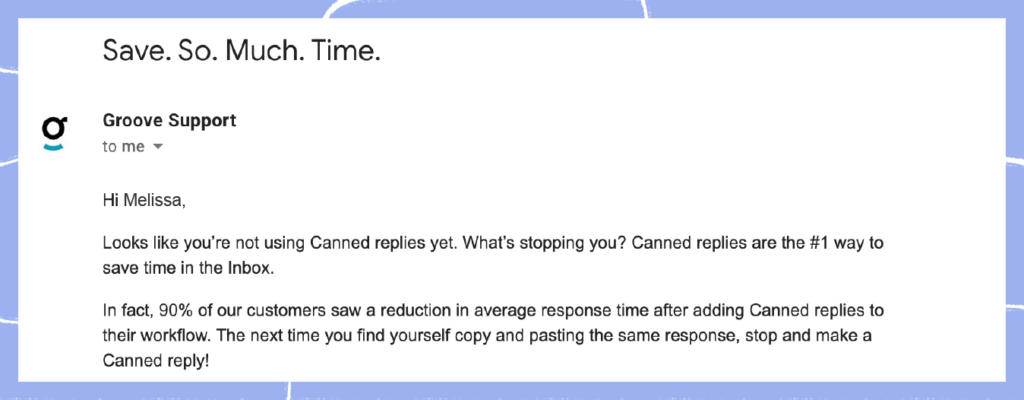
Even if you’re already using a product, using it in a different way seems challenging. We use this strategy to empathize with the customer, showing them that the solution to their problem is already within reach.
Customer success strategy #5: Touching base with current customers as they add new products
Whenever customers activate or add a new product to their account, we mark it as a customer success touchpoint.
Our plans include both an inbox and knowledge base. But our customers typically ramp up the inbox first. The knowledge base comes second.
This marks an ideal time for us to touch base. We’re notified when customers activate their knowledge base for the first time. Sometimes it’s shortly after they start with us. Sometimes it’s very far down the road.
But this action in itself helps us tailor our messaging for success.
We know they’re exploring. They’re getting more proactive. Maybe they hired more team members. We have our talking points.

We can pop into their inbox with some valuable resources to ensure their success.
Customer success strategy #6: Upselling current customers
The more obvious goal of many customer success strategies is upselling or cross-selling. More often than not, these practices should be accompanied by one of the above tactics too.
When checking in with a growing account like in tip #3, we might suggest they upgrade to a different plan that better fits their needs.
As a stand-alone strategy though, our best example is encouraging happy customers to move from a monthly to annual plan.

These customers have been with us for some time and are using the product effectively. It’s a cut-and-dry case of customer success benefiting both the customer and the business.
The customer will actually pay less to use our product over time. And we’ll have guaranteed income for a longer period. Win-win.
Customer success strategy #7: Offering new perks to current customers
As a customer success strategy, we want to let customers know we’re constantly innovating for them. Whether by adding new perks to their account or truly listening to their feedback.
For example, we recently started offering Office Hours. It’s a nice touch that our current customers appreciate. They can set up a call to discuss how to use Groove or how to solve certain problems.
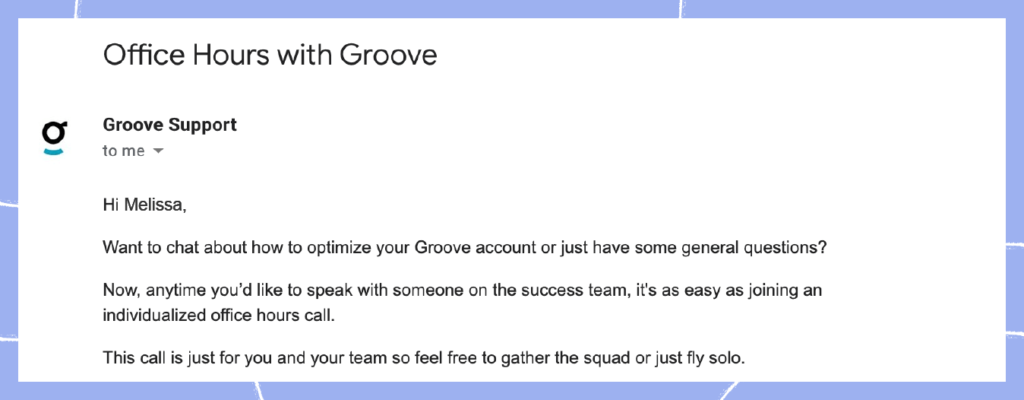
Whether they actually sign up for the call or not, customers appreciate the effort put in to fostering the relationship.
Customer success strategy #8: Providing extra assistance for high-risk potential customers
Our sales funnel brings potential customers through a free trial first. This trial period is a high priority for customer success.
We gather data during this time to assist every customer through onboarding and ensure a successful conversion. But we pay extra attention to those who veer from the norm.
In particular, we trigger an email when trialers don’t set up a mailbox. This is a crucial step in successfully using their inbox. If they don’t take this step, they really can’t do much else.
We explore some pain points they might be facing and offer help.
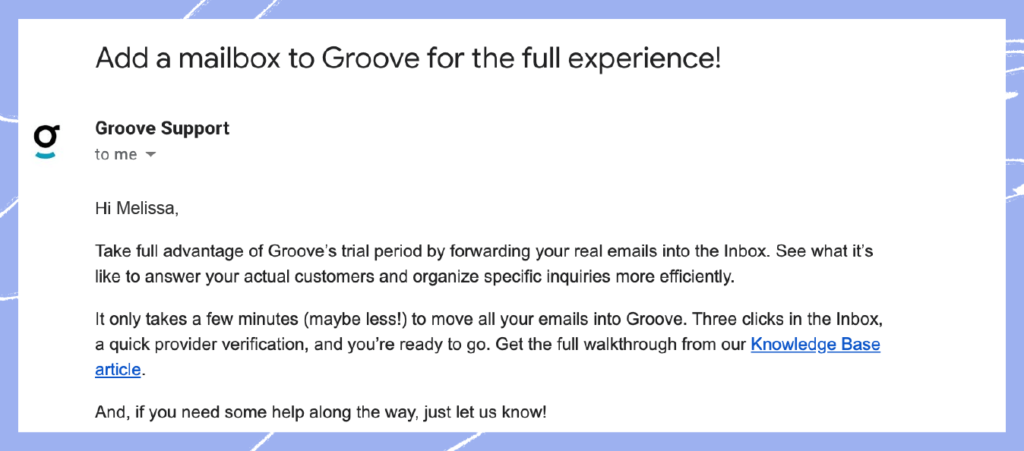
We assume that after getting a high level view of our product, they just weren’t interested. Or they forgot about us. Or it wasn’t what they thought it was.
Each of these reasons could give us valuable information on how to target future customers or improve onboarding. Which makes it all the more important to connect via email and get more information.
Customer success strategy #9: Spotting warning signs for high-risk current customers
There are some subtle (and plenty not-so-subtle) moves customers can make to tip to you off to their potential departure.
After spending years talking to customers, our Head of Customer Success & Support can sense an unhappy customer from miles away. We’ve scaled this strategy by setting up alerts for certain high-risk events.
One such instance occurs when accounts are inactive for fourteen days. This triggers an email from our success team.
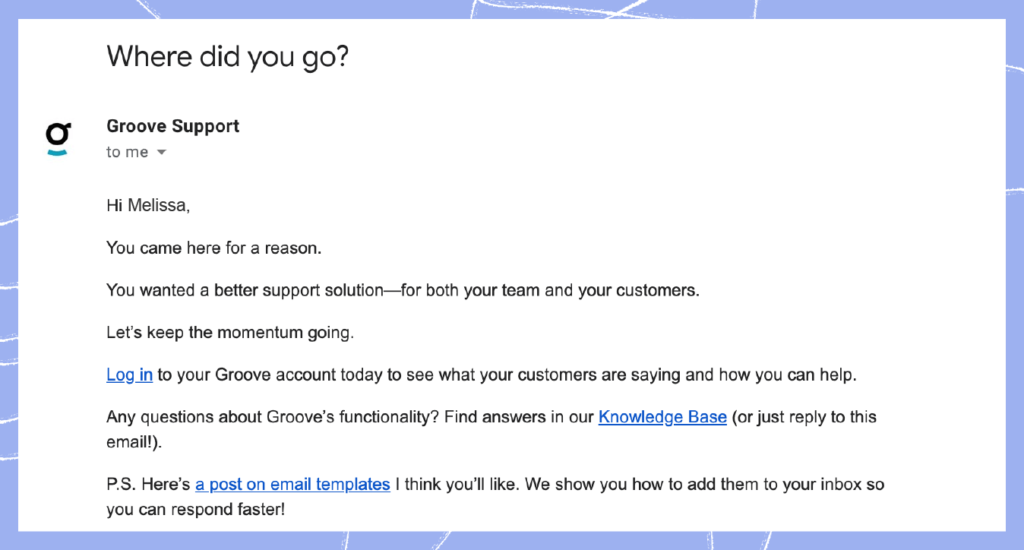
From conversations with customers, we know that fourteen days is too long to go without using your support software. Either their business is struggling or they’re using a different platform.
It’s a warning sign that our customer success team must act on if they want to rescue the account.
4 metrics to track customer success strategies
The metrics we use to track customer success are the same metrics we use to track overall business health.
The correlation between customer success and business growth is clear. But the individual customer success strategies from above are not singularly responsible for any of the metrics below.
When everything comes together though—customer success, support, product, marketing, sales—they’ll all tip the scales to improve the following.
Customer success metric #1: Churn
Customer churn describes the drop off in engagement with a customer, whether they no longer actively use a product or formally end a service agreement.
High churn rates signify low levels of customer satisfaction and decreased business growth.
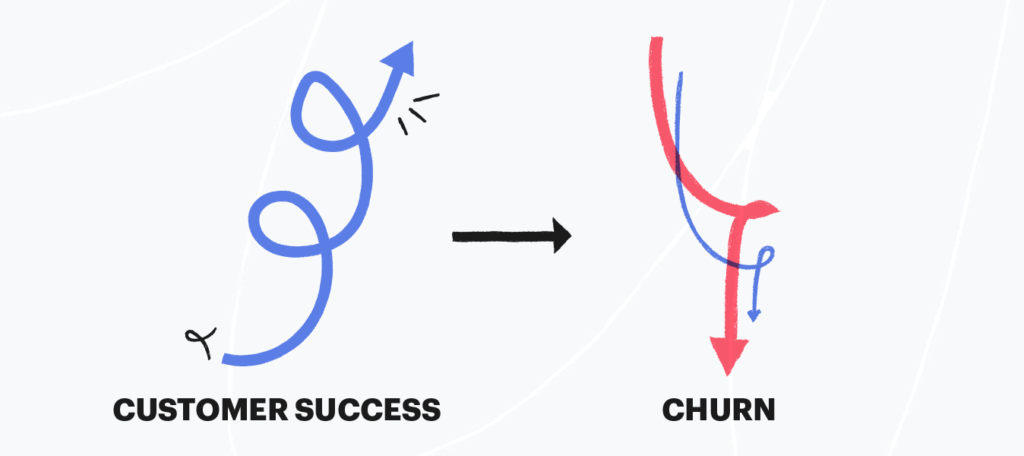
Customer success metric #2: Retention
Customer retention describes the ability of a company to maintain its current customer base after their initial acquisition.
High retention rates indicate customer desire to continue using a product or service, which leads to repeat purchases, increased revenue, and steady business growth.
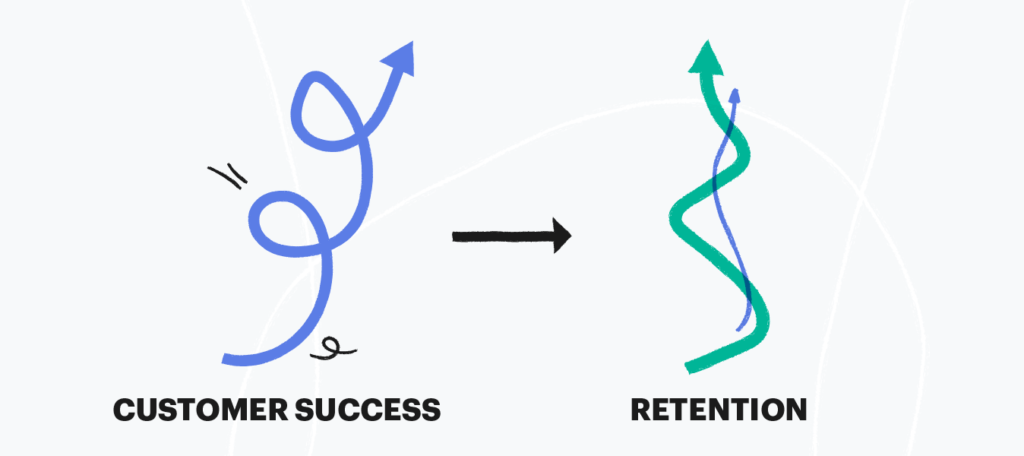
Customer success metric #3: NPS
NPS (Net Promoter Score) measures a customer’s desire to recommend a product or service. An NPS Survey generates the numerical value associated with this score by subtracting the percent of detractors from the percent of promoters for a given time period.
- Promoters: Customers who selected 9 or 10 on their NPS survey.
- Passives: Customers who selected 7 or 8 on their NPS survey.
- Detractors: Customers who selected 0-6 on their NPS survey.
NPS is measured on a -100 to +100 scale:
- -100-0 = Bad NPS
- 0-50 = Good NPS
- 50-70 = Excellent NPS
- 70-100 = World-class NPS

Customer success metric #4: Average resolution time
Average Resolution Time measures the amount of time lapsed from when a customer support agent first opens a customer’s email to when they send out a final reply signifying resolution of the query.
Help desk platforms track the exact time spent on each ticket then aggregate to provide an average resolution time.
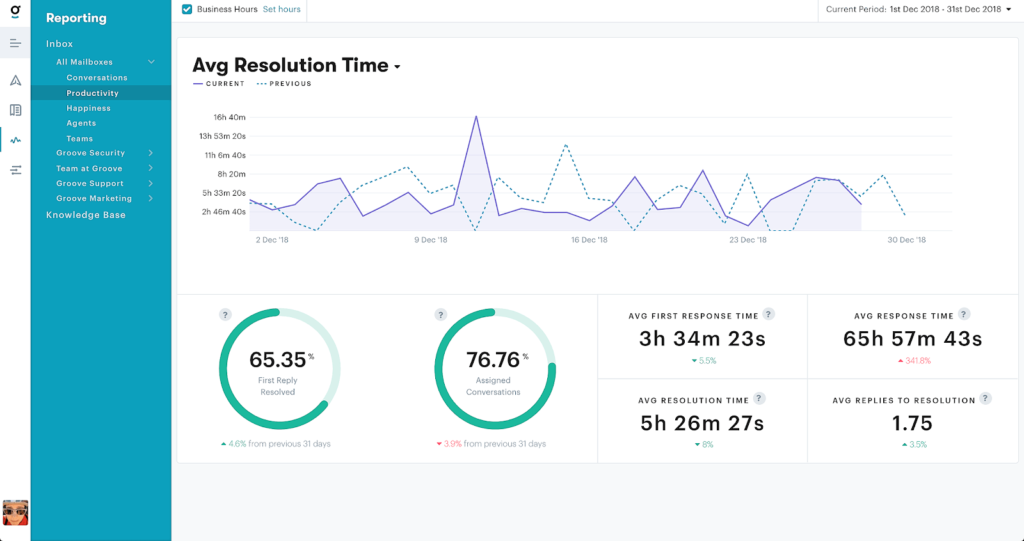
The more effort put into customer success strategies, the easier it will be for customer support to resolve tickets.
Customer success ensures that each customer has access to proactive resources, lowering the average resolution time within the inbox.
Putting a customer success strategy in place at your business
A customer success strategy isn’t one thing. It’s part of a larger strategy to grow your business and your customer base. It weaves through every department and provides value for every industry—regardless if your industry is technology, e-commerce, professional services, or retail.
Our customer success strategies involve a lot of creative thinking. But, as a startup, we make sure they don’t take too much time.
We set up automations, rely on trial and error, and move quickly when something works (or doesn’t work).
When setting up your own customer success strategy, the first hurdle to get over is the thought that you need a dedicated team or a fancy CRM.
You can do a lot with a little. Our nine strategies are proof. Pick your favorite one and start building your own portfolio of customer success strategies today.

